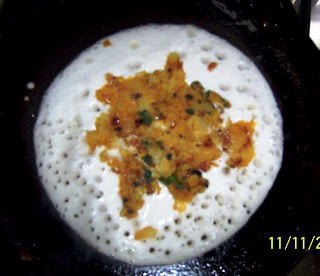
While hotel food in Goa is more accommodative to vegetarians, street food is almost always geared towards the meat eaters! Fried fish and fresh batter fried calamari, steaming fish curries and rice, chicken cooked in different styles, lamb vindalhos and pork sorpotels – and all this often accompanied by the rustic Goan bread – the butterfly shaped Poee. Similar to the Pav/Pau made famous by Mumbai’s famous Pao Bhaji, this bread is soft and spongy and can be found in shops as well as the small bakeries in Goa.
While slowly getting accustomed to the chilly days in Delhi as winter is setting in and mentally dreading the even colder temps to come in January, I had this sudden urge one lazy Friday when the three of us had bunked work and school, to bake something; as if the warmth of the oven might permeate the house too. And what better “warming” food to bake than bread!
I had just picked up Madhur Jaffrey’s book Flavours of India from the library and it had a recipe for Poee which seemed just the ticket for my mood.
I replaced a little less than half of the quantity of all purpose flour with wheat flour and half of the water quantity with milk. I also upped the quantity of yeast by one more teaspoon and brushed the tops of one batch of bread with a tsp of butter for a golden brown crust.
The first batch which I baked for 20 minutes at 220 C came out a bit crisper than what I wanted, so I baked the next batch for 15 minutes and reduced the temperature to 200C and they turned out softer.
The bread is great to eat with hot curries and in a kind of reverse planning, I started looking for a dish to accompany the Poee after I had finished baking them. I picked out Chicken Xacuti (Recipe here) from Madhur Jaffrey’s book again ; together they made a delicious meal.

Ingredients:
Active dry yeast - 1 tsp (I used 2 tsp)
Salt – ½ tsp
Water – 1 ½ cups (I used 1 cup water and ½ cup milk)
Sugar – 1 tsp
Method:
2. Combine the flour and salt in a big bowl, add the yeast mixture and milk/water to this and mix well. Knead the dough till it is soft, adding a splash of water if it is too dry. Keep some flour handy and add a little at a time if it seems too wet. Knead well for about 5 minutes and then roll into a large ball, cover with oiled cling wrap or a damp cloth and keep aside in a warm place for about 1 and half hours till it doubles in size.
3. Knead the dough again and divide into 6-8 portions. Roll each portion into a round and flatten a bit, then make a vertical slash over the top in the centre with a sharp knife.
4. With your fingers at the vertical slash, pull the dough apart gently from the centre to the sides. The ball will now look like an open book.
Serve as breakfast bread or as an accompaniment to a curry dish for a meal.














 Image credit: PNAS/National Academy of Sciences; pottery vessel from Honduras similar to the ones in which scientists found the earliest known evidence of the use of the cacao tree.
Image credit: PNAS/National Academy of Sciences; pottery vessel from Honduras similar to the ones in which scientists found the earliest known evidence of the use of the cacao tree.






